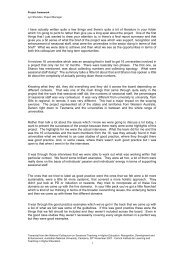A tutor's guide to teaching and learning at UQ - TEDI - University of ...
A tutor's guide to teaching and learning at UQ - TEDI - University of ...
A tutor's guide to teaching and learning at UQ - TEDI - University of ...
Create successful ePaper yourself
Turn your PDF publications into a flip-book with our unique Google optimized e-Paper software.
Section 3: Effective Small Group Teaching <strong>and</strong> Learning 25Techniques for group facilit<strong>at</strong>ionEnsuring equal particip<strong>at</strong>ionHaving a good group ‘clim<strong>at</strong>e’ is one <strong>of</strong> the main things <strong>to</strong> establish <strong>and</strong> maintain inorder <strong>to</strong> ensure active <strong>and</strong> equal particip<strong>at</strong>ion by all students in the group. Avoiding thedominance <strong>of</strong> a single member is an important role for you as the tu<strong>to</strong>r, as is supporting<strong>and</strong> encouraging the quiet student/s <strong>to</strong> contribute <strong>to</strong> particip<strong>at</strong>e. Here are some steps <strong>to</strong>take <strong>to</strong> ensure equal particip<strong>at</strong>ion <strong>of</strong> all students;♦♦♦♦♦♦The physical layout <strong>of</strong> the room should be arranged <strong>to</strong> encourage equalparticip<strong>at</strong>ion, e.g. sitting members in a circle so th<strong>at</strong> they face each other.Provide a set <strong>of</strong> 'rules' for discussion/group work– these may be some th<strong>at</strong> weregener<strong>at</strong>ed as ground-rules for the group in the first tu<strong>to</strong>rial (e.g. contributionscan only be made in turn, time limits may be set, comments in favour <strong>of</strong> an ideaare allowed only by comments against it, etc).You may find yourself filling silences by reverting <strong>to</strong> mini lectures. It is easier <strong>to</strong>draw all <strong>of</strong> the students in<strong>to</strong> a discussion if you know their names. Use a list ifyou can't rely on your memory. It is important however not <strong>to</strong> embarrass or forcecontributions from class members which may scare them <strong>of</strong>f <strong>of</strong> ever openingtheir mouths in class again! Perhaps inadvertently draw in the quieter ones byasking non-specific questions, e.g. "Wh<strong>at</strong> do you others think about Rachel'smodel for an altern<strong>at</strong>ive?"Consider telling students th<strong>at</strong> next week’s tu<strong>to</strong>rial session will involve adiscussion about “X”, <strong>to</strong> give anxious or shy students plenty <strong>of</strong> time <strong>to</strong> thinkabout the <strong>to</strong>pic <strong>and</strong> therefore feel more confident about sharing their ideasduring group discussion.Similarly, get students <strong>to</strong> brains<strong>to</strong>rm their ideas about the discussion <strong>to</strong>pic for afew minutes before starting the discussion, <strong>and</strong> perhaps get students <strong>to</strong> sharetheir brains<strong>to</strong>rming with the person next <strong>to</strong> them first.If students are required <strong>to</strong> form small groups, in selecting members for eachgroup, take in<strong>to</strong> account the likelihood th<strong>at</strong> any one member will "domin<strong>at</strong>e"perhaps from their personality characteristics or 'expert' knowledge.



